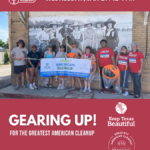KTB has had the honor of managing an EPA Grant through their Trash Free Waters program since 2020. KTB extends funds throughout the state to organizations working to prevent the flow of litter into the Gulf of Mexico.
On October 25th, Kirsten Sorensen, KTB’s Research and Cleanups Program Manager, met with new provisional affiliate Keep Pasadena Beautiful at El Jardin Beach in Houston. There they received instruction from Black Cat GIS on how to conduct a shoreline STOP audit. STOP stands for Stop, Track, RemOve, and Prevent, and is a method to conduct litter audits during cleanups.
El Jardin Beach is a recreational beach open to the public just off the Port of Houston. It’s a location that provides valuable insight into the kinds of litter produced by both the shipping channel and the surrounding area. Black Cat GIS is one of KTB’s EPA grantees. They developed the STOP methodology in conjunction with the Texas Litter Database to help collect robust data that can be interpreted using a geospatial model. The findings from this data helps tell the story of litter in Texas.

Conducting the STOP Litter Audit
After measuring a 100-foot transect on the shoreline, Keep Pasadena Beautiful and Black Cat GIS collected all visible trash. Then they took the collection to a picnic table off the beach to take a full inventory of items. Categories of items were separated, such as plastics, styrofoam, and paper, and individual items were counted. They found plastic bottles and bottle caps, cigarette butts, food containers, and more.
Keep Pasadena Beautiful are participants in an EPA-funded project to conduct STOP litter audits in their community. The funding supports the development of ways to incorporate audits in their practices to collect data in their community.



The Houston Shipping Channel
Black Cat GIS additionally took Kirsten on a tour of some of the most problematic shoreline litter locations in the city. This including the area where the Houston shipping channel opens into Galveston Bay. Black Cat regularly conducts litter cleanups in the area, audits the trash using the STOP method, and uploads that data into the Texas Litter Database. This helps them track trends over time and understand the story of what’s occurring in the area.
We’re grateful to both Black Cat GIS and Keep Pasadena Beautiful for their hard work!
To learn more about STOP litter audits, check out this webinar on How to Conduct a Litter Audit: The Hows and Whys of Data Collection by Amanda Hackney of Black Cat GIS, or visit their website at blackcatgis.com.
And stay tuned for highlights from Kirsten’s recent site visits to Buffalo Bayou and Galveston Bay.



